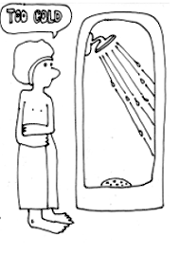|
|
||||||||||||||||||||
Household Energy Conservation Basics |
||||||||||||||||||||||||||||||||||||||||||||||||||||||||||||||||||||||||||||||||||
A real start to understanding energy use is knowing how much power things use. Many appliances use a lot of power but in short bursts. A microwave uses 750 watts per hour, but it only takes five minutes to cook a potato. That's only 62 watts! |
||||||||||||||||||||||||||||||||||||||||||||||||||||||||||||||||||||||||||||||||||
|
||||||||||||||||||||||||||||||||||||||||||||||||||||||||||||||||||||||||||||||||||
 |
||||||||||||||||||||||||||||||||||||||||||||||||||||||||||||||||||||||||||||||||||
|
This handy Kill-a-Watt Meter measures the power usage of individual appliances. You can figure out your electrical expenses by the hour, day, week, month, even an entire year.
Call Wholesale Solar to order: 1 800 472-1142 |
||||||||||||||||||||||||||||||||||||||||||||||||||||||||||||||||||||||||||||||||||
|
||||||||||||||||||||||||||||||||||||||||||||||||||||||||||||||||||||||||||||||||||
Tips for Lowering Energy Use in Your Home |
||||||||||||||||||||||||||||||||||||||||||||||||||||||||||||||||||||||||||||||||||
 |
The 15 percent of energy used in heating water in an average home can be lowered considerably by using a simple formula of insulating and conserving.
|
|||||||||||||||||||||||||||||||||||||||||||||||||||||||||||||||||||||||||||||||||
|
||||||||||||||||||||||||||||||||||||||||||||||||||||||||||||||||||||||||||||||||||
|
Thomas Edison would be turning in his grave if he knew abot the available technology and the lack of its application in the multi-billion dollar
light bulb industry.
|
||||||||||||||||||||||||||||||||||||||||||||||||||||||||||||||||||||||||||||||||||
|
||||||||||||||||||||||||||||||||||||||||||||||||||||||||||||||||||||||||||||||||||
 |
||||||||||||||||||||||||||||||||||||||||||||||||||||||||||||||||||||||||||||||||||
|
Some appliances draw close to the amount of power when turned off as they do when on.
Phantom loads
draw electricity 24 hours a day, even when the appliance is turned off.
A simple solution is to plug into a power strip, and turn the power strip 'off' when items are not in use. |
||||||||||||||||||||||||||||||||||||||||||||||||||||||||||||||||||||||||||||||||||
|
Common phantom
load users include:
|
||||||||||||||||||||||||||||||||||||||||||||||||||||||||||||||||||||||||||||||||||
For more energy savings tips. |
||||||||||||||||||||||||||||||||||||||||||||||||||||||||||||||||||||||||||||||||||
| Buy plug strips and use them! | ||||||||||||||||||||||||||||||||||||||||||||||||||||||||||||||||||||||||||||||||||
 |
||||||||||||||||||||||||||||||||||||||||||||||||||||||||||||||||||||||||||||||||||
Can you reduce your load? |


